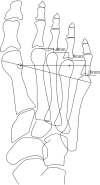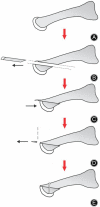Advances in the Causes and Treatment of Floating Toes after the Weil Osteotomy: A Scoping Review
- PMID: 38693601
- PMCID: PMC11144501
- DOI: 10.1111/os.14061
Advances in the Causes and Treatment of Floating Toes after the Weil Osteotomy: A Scoping Review
Abstract
The floating toe deformity is classified as a forefoot deformity wherein the distal portion of the toe does not establish touch with the ground, resulting in a suspended or elevated position while the finger is in a relaxed state. At first, it garnered considerable interest as a complication It is worth noting that this condition is particularly common in children under the age of 8, which usually disappears as the individual reaches maturity. Studies have shown that with the aggravation of floating toe deformity, its adverse effects on patients' gait and overall quality of life also increase. Despite the prevalence of floating toe deformity in clinical settings, there is a lack of comprehensive literature investigating its underlying causes and potential preventive strategies. This scope review follows the preferred reporting items for systematic reviews and meta-analyses extension for scoping reviews (PRISMA-ScR) statement guidelines for scope reviews. The literature was obtained from various full-text databases, including China National Knowledge Infrastructure Database (CNKI), Wanfang Database, PubMed, and Web of Science Database. Our search focused on published literature related to floating toes, Weil osteotomy, and distal metatarsal osteotomy, up until March 1, 2023. The literature search and data analysis are conducted by two independent reviewers. If there are any disagreements, a third researcher will participate in the discussion and negotiate a decision. Furthermore, two experienced foot and ankle surgeons conducted a thorough literature analysis for this review. Sixty-two articles were included. Through the clinical analysis of the structural changes of the forefoot before and after operation, the classification of floating toe was described, the causes of pathological floating toe were summarized, and the possible intervention measures for the disease were put forward under the advice of foot and ankle surgery experts. We comprehensively summarize the current knowledge system about the etiology of floating toe and put forward the corresponding intervention strategy. We recommend that future studies will focus on the improvement of surgical procedures, such as the combination of Weil osteotomy, proximal interphalangeal (PIP) arthrodesis and flexor tendon arthrodesis.
Keywords: Distal metatarsal osteotomy; Floating toe; Interventions; Surgical complications; Weil osteotomy.
© 2024 The Authors. Orthopaedic Surgery published by Tianjin Hospital and John Wiley & Sons Australia, Ltd.
Conflict of interest statement
All of the authors had no any personal, financial, commercial, or academic conflicts of interest separately.
Figures







Similar articles
-
Flexor digitorum brevis transfer for floating toe prevention after Weil osteotomy: a cadaveric study.Foot Ankle Int. 2013 Dec;34(12):1724-8. doi: 10.1177/1071100713502641. Epub 2013 Aug 26. Foot Ankle Int. 2013. PMID: 23978707
-
Floating-toe deformity as a complication of the Weil osteotomy.Foot Ankle Int. 2004 Sep;25(9):609-13. doi: 10.1177/107110070402500902. Foot Ankle Int. 2004. PMID: 15563380
-
Effectiveness of the dorsal thermoplastic locking orthosis to prevent floating toes in postoperative follow-up of Weil osteotomies: pilot study.Foot Ankle Spec. 2014 Oct;7(5):356-62. doi: 10.1177/1938640014532131. Epub 2014 May 2. Foot Ankle Spec. 2014. PMID: 24793064
-
Complications of the Weil osteotomy.Foot Ankle Spec. 2011 Jun;4(3):165-70. doi: 10.1177/1938640011402822. Epub 2011 Apr 13. Foot Ankle Spec. 2011. PMID: 21490179 Review.
-
[The Primary Metatarsalgia: Pathogenesis, Biomechanics and Surgical Treatment].Vestn Ross Akad Med Nauk. 2017;72(1):53-8. doi: 10.15690/vramn756. Vestn Ross Akad Med Nauk. 2017. PMID: 29308853 Review. Russian.
References
-
- McGlamry E. Floating toe syndrome. J Am Podiatr Med Assoc. 1982;72(11):561–568. - PubMed
-
- Fukuyama K, Maruyama H. Occurrence of floating toe from the viewpoint of the structure of foot arch. J Phys Ther Sci. 2011;23(1):33–36.
-
- Vandeputte G, Dereymaeker G, Steenwerckx A, Peeraer L. The Weil osteotomy of the lesser metatarsals: a clinical and pedobarographic follow‐up study. Foot Ankle Int. 2000;21(5):370–374. - PubMed
-
- Migues A, Slullitel G, Bilbao F, Carrasco M, Solari G. Floating‐toe deformity as a complication of the Weil osteotomy. Foot Ankle Int. 2004;25(9):609–613. - PubMed
-
- Ramisetty N, Greiss M. The Weil osteotomy: a seven‐year follow‐up. J Bone Joint Surg Br. 2007;89(2):280. - PubMed
Publication types
MeSH terms
Grants and funding
- 81373802/National Natural Science Foundation of China
- Z191100006619024/Beijing Science and Technology Planning Project
- WJYY-XZKT-2023-18/Wangjing Hospital of China Academy of Chinese Medical Sciences High-level Traditional Chinese Medicine Hospital Construction Project Evidence-Based Clinical Research on Traditional Chinese Medicine
LinkOut - more resources
Full Text Sources

